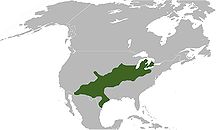Massassauga rattlesnake
| Massasauga | |
|---|---|
 |
|
| Scientific classification | |
| Kingdom: | Animalia |
| Phylum: | Chordata |
| Class: | Reptilia |
| Order: | Squamata |
| Suborder: | Serpentes |
| Family: | Viperidae |
| Genus: | Sistrurus |
| Species: | S. catenatus |
| Binomial name | |
|
Sistrurus catenatus (Rafinesque, 1818) |
|
 |
|
| Synonyms | |
|
|
The massasauga (Sistrurus catenatus) is a rattlesnake species found in midwestern North America from southern Ontario to northern Mexico, and parts of the United States in between. Three subspecies are currently recognized including the nominate subspecies described here. As with all rattlesnakes, it is a pit viper (and as with all pit vipers, it is venomous).
The adults are not large, ranging from 60 to 75 cm (24 to 30 in) in length. The color pattern consists of a grey or tan ground color with a row of large rounded brown/black blotches or spots down the center of the back and three smaller rows of alternating spots down each side. Solid black melanistic examples are also known, as well as cases where the back blotches join with those on the sides. Young massasauga are well-patterned but paler than the adults. It has heat-sensing pits on each side of its smallish head, the scales are keeled and the anal scale is single.
Massasauga, massasauga rattlesnake, massasauga rattler (Ontario), black massasauga, black rattler, black snapper, gray rattlesnake (Iowa), little grey rattlesnake (Canada), muck rattler, prairie rattlesnake, spotted rattler, swamp rattler, víbora de cascabel (Mexico), dwarf prairie rattlesnake, eastern massasauga great adder, ground rattlesnake, Kirtland's rattlesnake, little black rattlesnake, Michigan point rattler (Michigan), prairie massasauga, rattlesnake, small prairie rattlesnake, snapper, swamp massasauga, swamp rattlesnake, and triple-spotted rattlesnake.
The Native American word, "massasauga", means "great river-mouth" in the Ojibwe language and was probably given to describe grasslands surrounding the river deltas in Ojibwe country.
Found in North America from Ontario (Canada) and western New York State southwest to southeastern Arizona and northern Tamaulipas, Mexico. In Mexico, isolated populations exist in southern Nuevo León, north-central Coahuila and in Samalayuca, Chihuahua. It occurs in various habitats ranging from swamps and marshes to grasslands, usually below 1500 m elevation. The type locality given is "... on the prairies of the upper Missouri" (Valley, USA).
...
Wikipedia

